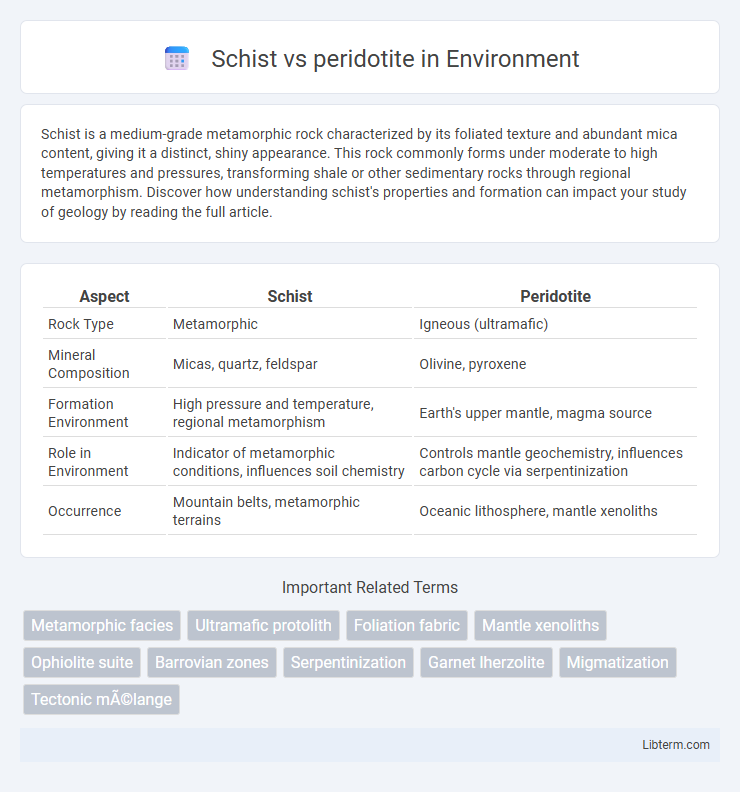Schist is a medium-grade metamorphic rock characterized by its foliated texture and abundant mica content, giving it a distinct, shiny appearance. This rock commonly forms under moderate to high temperatures and pressures, transforming shale or other sedimentary rocks through regional metamorphism. Discover how understanding schist's properties and formation can impact your study of geology by reading the full article.
Table of Comparison
| Aspect | Schist | Peridotite |
|---|---|---|
| Rock Type | Metamorphic | Igneous (ultramafic) |
| Mineral Composition | Micas, quartz, feldspar | Olivine, pyroxene |
| Formation Environment | High pressure and temperature, regional metamorphism | Earth's upper mantle, magma source |
| Role in Environment | Indicator of metamorphic conditions, influences soil chemistry | Controls mantle geochemistry, influences carbon cycle via serpentinization |
| Occurrence | Mountain belts, metamorphic terrains | Oceanic lithosphere, mantle xenoliths |
Introduction to Schist and Peridotite
Schist is a medium- to coarse-grained metamorphic rock characterized by pronounced foliation and abundant mica minerals, formed under moderate to high temperature and pressure conditions. Peridotite is a dense, coarse-grained ultramafic igneous rock composed predominantly of olivine and pyroxenes, originating primarily from the Earth's mantle. The contrasting formation processes and mineral compositions of schist and peridotite make them key indicators of different geological environments and metamorphic histories.
Geological Formation Processes
Schist forms through regional metamorphism involving intense heat and pressure that realign minerals into layered structures, typically originating from shale or mudstone. Peridotite is an ultramafic igneous rock primarily formed in the Earth's mantle through partial melting of mantle material and subsequent cooling. The contrasting geological formation processes highlight schist as a metamorphic rock shaped by tectonic forces, while peridotite represents deep mantle processes linked to magma genesis.
Mineral Composition Comparison
Schist primarily consists of abundant mica minerals such as biotite and muscovite, along with quartz and feldspar, giving it a foliated texture. Peridotite is dominated by olivine and pyroxenes, especially orthopyroxene and clinopyroxene, resulting in a coarse-grained, ultramafic composition. The key mineralogical difference lies in schist's high mica content versus peridotite's richness in mafic silicates like olivine.
Physical Properties and Texture
Schist exhibits a foliated texture with distinct mineral layers and a moderate to coarse grain size, characterized by its shiny, platy minerals such as mica. Peridotite has a coarse-grained, granular texture dominated by olivine and pyroxene, typically appearing dense and heavy with a non-foliated structure. Schist is often softer and more prone to cleavage, while peridotite is extremely dense and hard, reflecting its ultramafic mineral composition.
Color and Appearance Differences
Schist typically exhibits a foliated texture with visible mineral grains, often appearing in shades of gray, green, or brown, with a shiny or glittery surface due to mica content. Peridotite is coarse-grained and dense, characterized by its dark green to black color, dominated by olivine and pyroxene minerals, giving it a more uniform and dull appearance. These color and textural differences are key indicators in identifying the two metamorphic and igneous rocks.
Common Locations and Occurrence
Schist commonly occurs in regional metamorphic belts such as the Appalachian Mountains and the Scottish Highlands, forming under medium to high-grade metamorphic conditions. Peridotite is predominantly found in the Earth's mantle and is exposed at the surface in ophiolite complexes like the Oman Ophiolite and the Josephine Peridotite in California. Schist is typical in continental crust environments, whereas peridotite is a major component of the upper mantle and rarely exposed on the Earth's surface except in tectonic uplift zones.
Uses in Industry and Construction
Schist is widely used as decorative stone and for interior finishes due to its foliated texture and ability to be split into thin slabs, making it suitable for countertops, flooring, and wall cladding. Peridotite, rich in olivine and pyroxenes, is primarily utilized in the production of refractory materials and as a source of magnesium and nickel in the metallurgical industry. Its dense, durable nature also makes peridotite valuable for road base construction and aggregate in heavy-duty infrastructure projects.
Role in Plate Tectonics
Schist, a metamorphic rock rich in mica minerals, forms in subduction zones where intense pressure facilitates the recycling of oceanic crust, influencing mountain-building processes. Peridotite, an ultramafic rock from the Earth's mantle, is a primary source of magma generation at mid-ocean ridges, driving seafloor spreading and mantle convection. Both rocks play critical roles in plate tectonics by enabling crustal deformation and mantle dynamics essential to lithospheric movement.
Identification and Classification Techniques
Schist is identified by its foliated texture with visible mica flakes and banded mineral patterns, classified under medium-grade metamorphic rocks through petrographic analysis and X-ray diffraction. Peridotite is recognized by its coarse-grained, ultramafic composition dominated by olivine and pyroxenes, classified as an igneous rock using geochemical assays and thin section petrography. Advanced techniques like electron microprobe analysis aid in differentiating their mineral assemblages for precise classification.
Schist vs Peridotite: Key Differences Summarized
Schist and peridotite differ primarily in their mineral composition and formation environment; schist is a foliated metamorphic rock rich in mica and formed under moderate to high temperature and pressure conditions, whereas peridotite is an ultramafic igneous rock composed mainly of olivine and pyroxene, originating from the Earth's mantle. Schist exhibits visible layers and schistosity due to the alignment of platy minerals, while peridotite has a coarse-grained, dense texture without foliation. These differences indicate distinct geological processes, with schist often forming in regional metamorphic settings and peridotite representing mantle-derived material often associated with tectonic plate boundaries.
Schist Infographic

 libterm.com
libterm.com